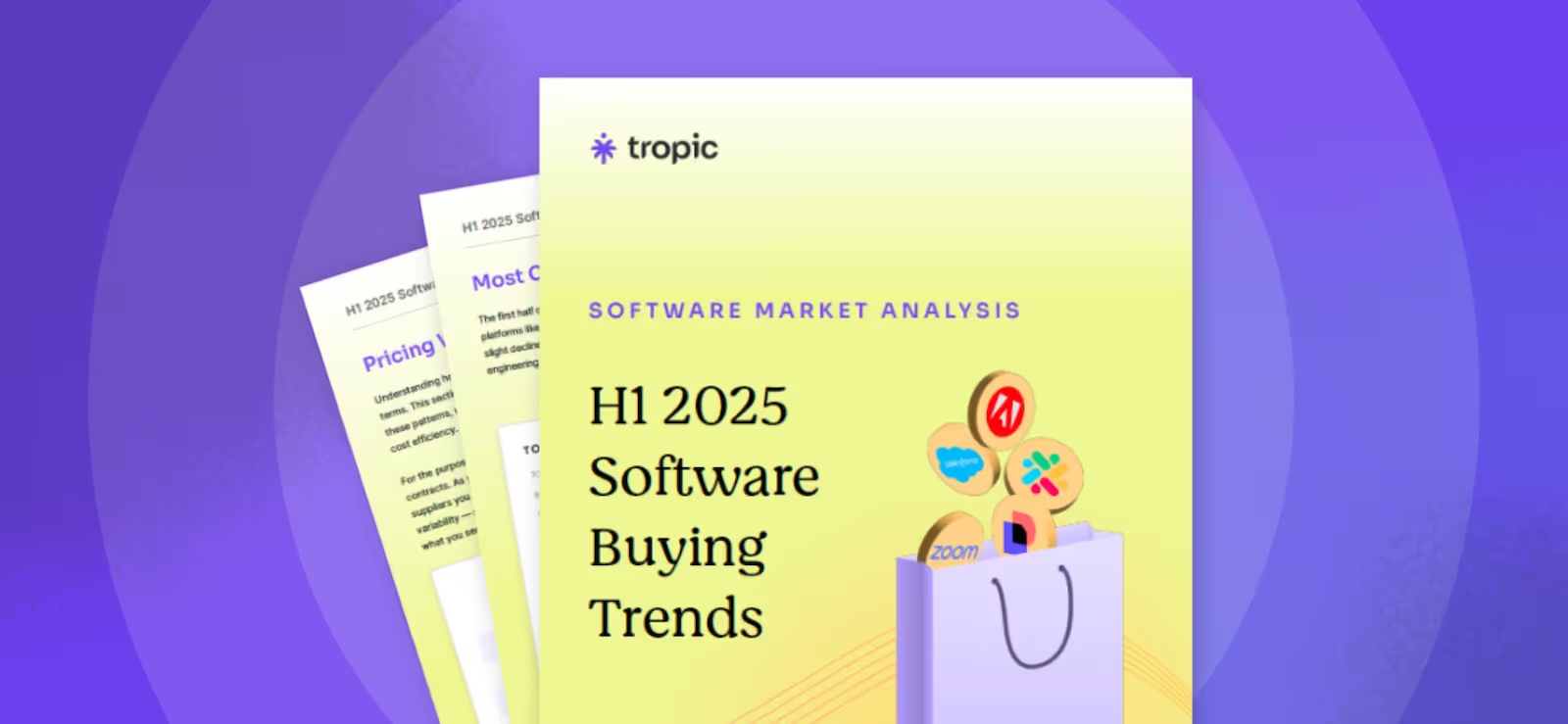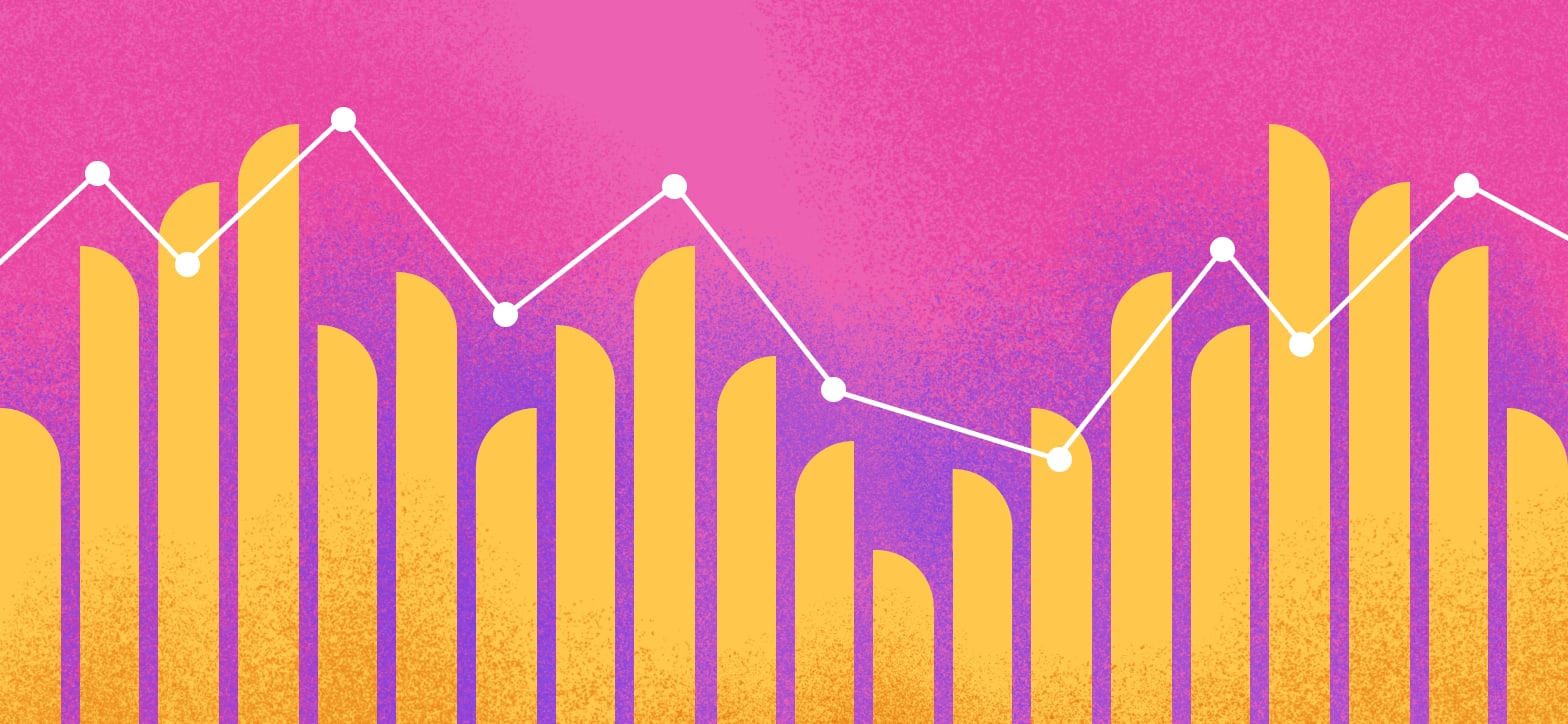SaaS Procurement Predictions for 2026
Executive Summary
Based on analysis of over $15 billion in software spend across SMB, Growth, and Mid-Market companies:
- Timing drives savings: Companies negotiating 6 months ahead save up to 39% more vs. 14% for those starting 30 days out
- AI adoption accelerates: 86% of organizations plan to implement or scale AI by 2026, with purpose-built AI companies seeing 468-2,031% YoY growth
- Contract terms lengthening: Average new contract increased 4.6% to 15.1 months despite economic uncertainty
- Usage-based pricing dominates: Consumption-based suppliers now show significantly higher spend variance than fixed-cost alternatives
- Consolidation continues: Legacy collaboration tools declining as teams rationalize stacks around ROI, not cost-cutting alone
Introduction
2025 marked a turning point. Procurement teams moved from reactive deal-chasing to proactive strategy. AI became real infrastructure instead of experimentation. Finance, IT, and procurement finally started speaking the same language.
Now we're looking ahead to 2026—a year where procurement stops playing catch-up and starts defining how software buying actually works. These predictions come from what we're seeing across thousands of vendor negotiations, renewal cycles, and procurement teams building the future in real time.
Our H1 2025 Software Buying Trends Report analyzed market trends and procurement patterns from over $15 billion in spend under management. The data reveals where software investment is headed and how teams can drive smarter, more strategic decisions for the rest of 2025 and into 2026.
1. Procurement AI Starts Taking Action
The Trend: AI adoption is accelerating fast. Our data shows 86% of organizations plan to implement or scale AI by 2026. Purpose-built AI companies are dominating growth charts—Cursor saw 86% YoY growth, Clay 468%, and Anthropic 2,031%.
But adoption is just the beginning. In 2025, AI gave teams visibility. In 2026, it will start making moves.
What's Next: We'll see systems capable of drafting contract language, generating negotiation recommendations, and even executing renewals within policy limits. This isn't about replacing people—it's about letting humans focus on strategy instead of repetitive tasks.
How to Prepare: The procurement leaders who benefit most won't be the ones chasing every new AI feature. They'll be the ones who define clear guardrails so automation scales what already works. Procurement will finally operate at the speed of its own insights.
2. SaaS Pricing Gets Unpredictable
The Trend: Usage-based pricing is already creating significant budget unpredictability. Our H1 2025 data shows suppliers like Datadog and Twilio—operating on consumption-based models—experience significantly higher spend variance than fixed-cost suppliers. While non-usage-based suppliers show relatively stable fluctuations close to contract terms, usage-based suppliers experience higher volatility with significantly greater swings in contract variance.
What's Next: Static seat-based pricing is vanishing. In 2026, vendors will push dynamic pricing models that evolve mid-contract. Expect performance-linked tiers, cross-product discounts, and loyalty-based incentives that reward multi-year commitments.
It sounds flexible, but it adds complexity. Vendors are already running predictive pricing models powered by their own AI. Procurement teams need to match that sophistication.
How to Prepare: The best teams will track real usage data, benchmark continuously, and negotiate for elasticity—agreements that flex with business needs instead of locking them in. Build flexibility into contracts with price caps, volume thresholds, and renegotiation clauses.
3. Vendor Risk Goes Real-Time
The Trend: Vendor landscapes are changing quickly. In just one year, companies like Carta, Zendesk, Google Workspace, and Greenhouse dropped off our most-used tools list. Meanwhile, legacy collaboration platforms like Slack and Zoom are seeing adoption declines as consolidation efforts mature.
What's Next: Vendor risk used to be something you checked annually. That won't cut it anymore. Mergers, layoffs, funding cliffs, and data breaches can reshape a supplier's profile in a week.
In 2026, procurement will treat vendor health like financial data: live, dynamic, and continuously monitored. AI will flag when a vendor's risk score changes, when new compliance rules appear, or when an acquisition alters their roadmap.
How to Prepare: Procurement will stop reacting to surprises and start anticipating them. Set up continuous monitoring systems that track vendor health metrics in real-time.
4. Stack Rationalization Becomes a Strategic Advantage
The Trend: Our H1 2025 data shows companies are removing unnecessary software, but not uniformly. Mid-Market companies saw a 7% increase in average spend per employee, while SMB saw a 1% decrease and Growth Stage saw a 6% decrease. Total spending increased around 15% YoY, but there was a 9% decrease between Q1 and Q2 2025.
What's Next: Most companies still treat software rationalization like a budget-cutting exercise. In 2026, it becomes a strategic discipline. The question shifts from "What can we cut?" to "Where do we have redundancy, overlap, or opportunity?"
Procurement, not finance, will lead this work. Using spend intelligence tools, teams will model scenarios before making decisions—forecasting the impact of consolidation or expansion.
How to Prepare: Rationalization becomes less about cutting and more about aligning spend with value. The result: smaller stacks, smarter systems, and clearer accountability for every tool. Calculate what you're spending on software and compare it to similar-stage companies using actual benchmarks.
5. Procurement Playbooks Turn Into Living Systems
The Trend: Pricing variability data shows negotiation leverage varies wildly by vendor. Some suppliers like DocuSign show pricing ranges from -48.8% to 62% of standard rates, while Figma shows 0% variability—what you see is what you get. Atlassian ranges from -15.8% to 27.3%, while LinkedIn shows minimal variance at -4.3% to 2.8%.
What's Next: Procurement teams have long relied on internal playbooks—static docs filled with negotiation tactics and vendor histories. In 2026, those playbooks become data-driven systems.
Instead of updating documents manually, teams will use software that captures outcomes from every deal, renewal, and negotiation. AI will learn which strategies work against which vendors and automatically suggest the right approach next time.
How to Prepare: Use declining adoption among legacy vendors as leverage to counter annual uplifts. For tools under competitive pressure like those showing high pricing variability, request flexibility on term length, price caps, or bundling opportunities. For vendors with minimal variability, focus negotiation efforts elsewhere. Procurement becomes self-optimizing, and institutional knowledge stops walking out the door when someone leaves.
6. ESG and Compliance Shift from Checkboxes to Decision Drivers
The Trend: Buyers are becoming more selective and ROI-driven. Security and operations platforms like Okta, 1Password, and NetSuite are gaining traction due to increased scrutiny on governance and visibility.
What's Next: Procurement has always been a gatekeeper for compliance. In 2026, it becomes a driver of brand trust. ESG performance—environmental impact, data ethics, and workforce diversity—will start influencing buying decisions as much as pricing and security do.
Expect RFPs to include sustainability metrics. Expect leadership to ask for vendor diversity breakdowns. Expect auditors to request ESG documentation alongside SOC 2 reports.
How to Prepare: The companies that already track this data will have the upper hand. Procurement will own more than spend—it'll own reputation.
7. Finance, IT, and Procurement Finally Operate as One System
The Trend: Shadow spend remains a major challenge. Our data shows the top suppliers creating shadow IT problems include OpenAI, LinkedIn, Figma, GitHub, Adobe, Calendly, Canva, Twilio, Atlassian, Zapier, and JetBrains. Many offer freemium functions that quickly turn into organization-wide tools via credit card swipes—bypassing procurement entirely and missing out on negotiated pricing and volume discounts.
What's Next: For years, Finance, IT, and Procurement have shared goals but not data. That ends in 2026. Spend visibility, usage metrics, and renewal calendars will live in shared dashboards. Everyone will see the same numbers in real-time.
How to Prepare: The result: fewer misaligned budgets, cleaner forecasting, and faster decision-making. Procurement will no longer chase finance for context or IT for usage data. Centralize contract and spend data in one system. Create clear policies for software purchases, pre-approved vendor lists, and automated approval workflows to catch rogue purchases. When all teams look at the same truth, procurement shifts from "support function" to "strategy partner."
8. Predictive Intelligence Replaces Reactive Cost-Cutting
The Trend: More than 30% of renewals happen in Q4, but companies that wait until the last minute leave savings on the table. Our data proves timing matters: companies starting negotiations 6 months out achieve up to 39% more savings, those starting 60 days out see 22% savings improvement, and those starting just 30 days out only capture 14% improvement.
What's Next: Procurement's old superpower was saving money. Its new one is predicting where waste will happen. In 2026, AI models will forecast underutilized licenses, identify rising vendor risk, and recommend alternative suppliers before renewals hit.
How to Prepare: The move from reactive to predictive transforms procurement's role entirely. It's no longer about reacting to renewal notifications. It's about controlling spend before spend happens. Set up continuous monitoring of your tech stack, renewals, and sourcing needs rather than annual check-ins.
9. Procurement Leaders Step Into Strategic Visibility
The Trend: Tools that support engineering, product, and infrastructure like Atlassian and Figma are seeing rapid adoption as organizations prioritize scalability, intuitive UX, and integration. Organizations are less tolerant of price hikes from legacy tools unless clearly tied to new value or innovation.
What's Next: The title "Chief Procurement Officer" won't just exist—it'll matter. In 2026, procurement leaders will own KPIs tied directly to margin, resilience, and risk management. They'll shape budgets instead of just enforcing them.
How to Prepare: When the board wants to understand operational efficiency or vendor exposure, they'll turn to procurement first. The teams that build systems for predictive intelligence now will be the ones running the show a year from now. Anchor renewal conversations around ROI, not just pricing; demonstrate how strategic tools drive engineering velocity, security, or operational resilience.
How the Data Supports These Predictions
Every prediction above is grounded in patterns we're seeing across our $15 billion dataset:
On AI and automation: 86% of organizations plan AI implementation by 2026, with top AI companies seeing 86-2,031% YoY growth
On pricing complexity: Usage-based suppliers show significantly higher variance than fixed-cost contracts, with consumption models now dominating fast-growing vendors
On timing leverage: 6-month advance negotiations yield 39% more savings vs. 14% for 30-day starts
On contract trends: Average contract length rose 4.6% to 15.1 months despite economic uncertainty
On consolidation: Legacy tools declining in adoption while ROI-driven platforms gain traction, with companies removing unnecessary software across segments
On shadow IT: 11 major suppliers consistently bypass procurement through freemium adoption
On vendor shifts: Multiple established tools dropped from top-adoption lists YoY, proving vendor landscapes change rapidly
Your Next Steps
2026 isn't about procurement keeping up. It's about procurement leading. The teams that embrace intelligence, automation, and collaboration will stop being seen as cost controllers and start being recognized as strategic operators.
Start now:
- Audit your Q4 renewals and move high-value negotiations forward by at least 60 days
- Benchmark your software spend per employee against similar-stage companies (SMB: $14k, Growth: $8k, Mid-Market: $7.3k average)
- Identify shadow IT risks using our top-11 list as a starting point
- Review pricing variability data for your top vendors to focus negotiation efforts where they'll have the most impact
- Build price protection mechanisms into new contracts, especially for usage-based vendors
- Implement continuous vendor health monitoring instead of annual reviews
About This Analysis
This report is based on Tropic's H1 2025 Software Buying Trends analysis, covering over $15 billion in spend under management across SMB (1-100 employees), Growth (101-250 employees), and Mid-Market (251-999 employees) companies.
Tropic is your intelligent procurement partner, purpose-built to help modern finance and procurement teams save time, cut costs, and drive impact. Recognized as a Grid Leader and Momentum Leader on G2, we combine AI agents and expert services to handle the procurement work you don't have time for—from complex negotiations to renewal management.







